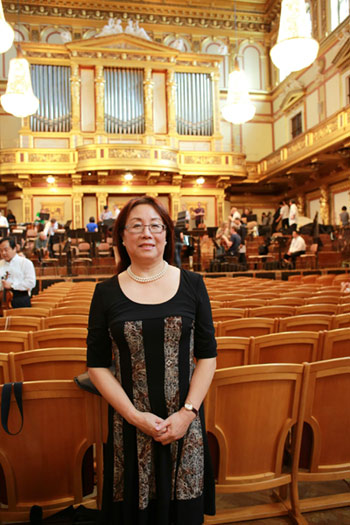Return to sender
Updated: 2012-08-25 08:01
By Raymond Zhou (China Daily)
|
|||||||||||
|
 Alliance of Asia-Pacific Region Orchestra Chairwoman Guo Shan attends a rehearsal for the orchestra's 2012 European tour at the Slovak Philharmonic Hall in Bratislava, capital of Slovakia. Photos by Guo Lei / For China Daily |
The doyenne of symphonic music in the Asia-Pacific region takes some of the best talent from the region to the home base of classical music, writes Raymond Zhou from Bratislava, Slovakia.
When the glorious brass sound of the beginning of Tchaikovsky's Symphony No 4 was blasted across the Slovak Philharmonic Hall in Bratislava, capital of Slovakia, it brought tears to Guo Shan.
It was not even a formal performance, just the first rehearsal for the 2012 European tour by the Asia-Pacific United Orchestra.
"I can have peace of mind knowing that the musicians put their heart and soul into their work," says Guo, chairwoman of the Alliance of Asia-Pacific Region Orchestra. "You can feel the passion they put into the music. It's not just a job they do, they really love making beautiful music."
However, Guo does not see the musicians of this orchestra on a daily basis. Some of them she had just met for the first time. They hail from 27 orchestras from all over - and even beyond - the Asia-Pacific region, 20 countries to be exact. There are Asians working in Europe and America, and vice versa.
"Most of them are in their 30s or 40s, the prime of their careers, and most of them are principals or associate principals of their respective orchestras," Guo explains.
Guo, who started learning the piano at the age of 12 and spent decades managing classical music institutions in China, is on a mission: She wants to showcase the best of classical music from the region.
"The word 'Asia' does not conjure up classical music in the West, yet China alone has more than 60 professional symphonic orchestras. When an executive from a recording company of a Western country asked me whether Asia has any orchestra worth recording, I was really hurt," Guo says.
Asia Pacific is a vibrant place when it comes to classical music, according to Guo, who has also been the chairwoman of the China Symphony Development Foundation since 2004. China has a fast growing fan base that is the envy of orchestra administrators in the West because much of its clientele is young and upwardly mobile.
At the same time, talent is pouring into Asia Pacific. Every year, young musicians trained in Western countries return to their homeland as more jobs open up in the emerging market. Even accomplished musicians whose home countries are not in the region seek out opportunities around the Pacific Ocean. The exchange of talent is no longer limited to one-off events, but has become a regular feature in the business.
"The best way to tell the world about us is not to talk or write about it, but present concerts so that people can judge for themselves," Guo says. "But here in Europe, even taxi drivers can be connoisseurs in the art form. They'll not be impressed if you don't measure up. And here we are, the best from Asia Pacific."
A program for this purpose has to take into account many factors, including the season of summer when classical music shifts from the black-tie mode to a more casual style of country festivals and open-air gatherings.
"We have to incorporate a sample of Asian music. Some would go for the noisy type fit for opening a show, but we want something classier. Out of a multitude of pieces we considered, we chose The Stream Flows, a Chinese folk melody that Bright Sheng, a Chinese composer active on the world stage, adapted for a four-movement suite for the Seattle Symphony Orchestra.
"It has Asian color, yet its orchestration for strings is quite modern in style. A simple melody receives myriad variations, evoking and enhancing the emotions of this beautiful love song. It is elegant, not raucous."
The second piece is Beethoven's piano Concerto No 4 in G Major. It is an acknowledgement to the German-Austrian school of music so central to the classical canon, and the tour is centered around Vienna, the capital of music, and neighboring countries in its sphere of musical influence, including Slovakia, Czech Republic, Estonia and Finland.
Then there is Tchaikovsky's Symphony No 4 in F Minor, a popular choice that at the same time adds one more dimension to the repertory.
In 2010, Guo took the same orchestra, with varying members, to the United Nations General Assembly Hall, in a concert that sang the praises of the bounty that Mother Nature has endowed us.
Now, the 74 members are even more diverse in ethnic and national origins, reflecting a significant part of our increasingly integrated world. When these musicians get on stage, whatever differences that existed would vanish, enveloping everyone within earshot with cascading sounds of beauty.
Contact the writer at raymondzhou@chinadaily.com.cn.
Today's Top News
Rescuers race against time for quake victims
Telecom workers restore links
Coal mine blast kills 18 in Jilin
Intl scholarship puts China on the map
More bird flu patients discharged
Gold loses sheen, but still a safe bet
US 'turns blind eye to human rights'
Telecom workers restore links
Hot Topics
Lunar probe , China growth forecasts, Emission rules get tougher, China seen through 'colored lens', International board,
Editor's Picks

|

|

|

|

|

|





